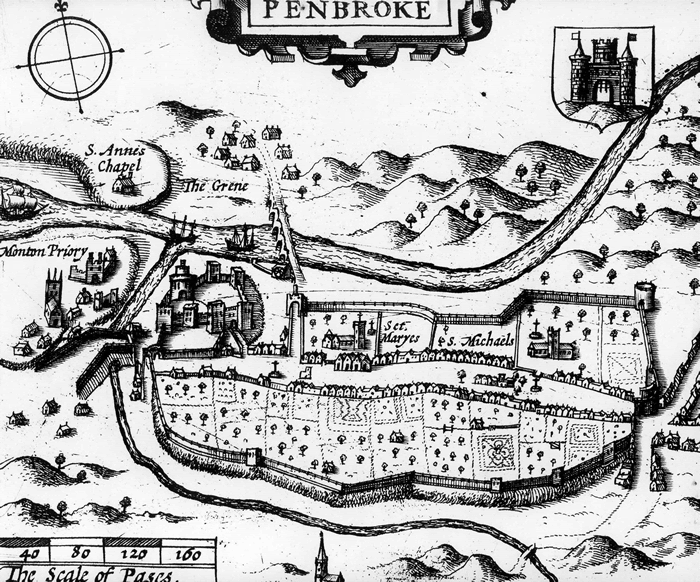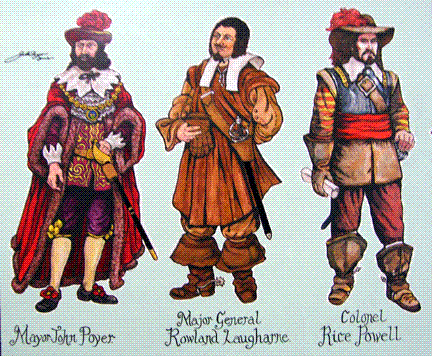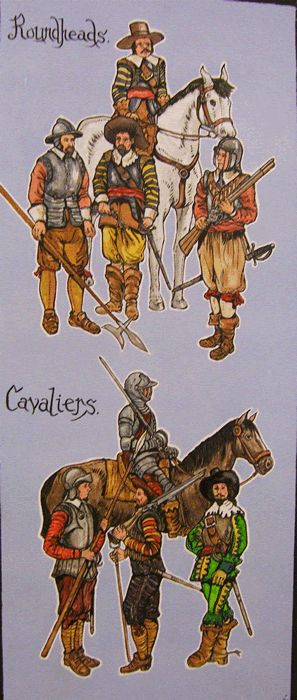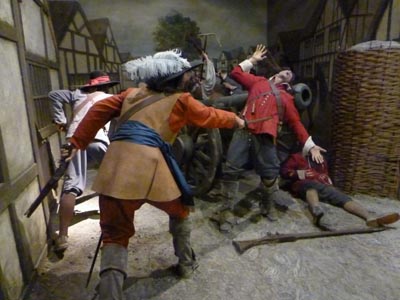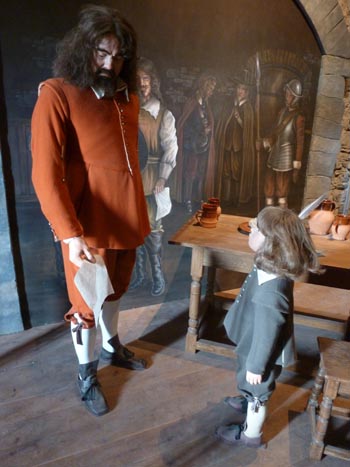
| HOME | ABOUT | PEMBROKE | MONKTON | HISTORY | LANDSCAPE | GALLERIES | PUBLICATIONS | CONTACTS |
Pembroke s
Stuart Period and Civil WarKing James I made a gift of PembrokeCastle to a Welsh Gentry Family, the Pryses of Gogerddan in Cardiganshire. No longer important as an administrative centre and militarily obsolete, it appeared that it was no longer of any strategic use. But ... Pembroke was to play one last leading role in British history – during the Civil Wars 1642 - 1648 Whatever were the causes of war, in Pembroke there was considerable anti-monarchy feeling as a result of depression. John Speed the cartographer said in the early seventeenth century that it was “more ancient in show than it is in years, and more houses without inhabitants than I saw in any one city throughout my journey” .
John Speed's map of 1611 The influential Sir Hugh Owen of Orielton was a Parliamentarian and represented Pembroke in the Long Parliament 1640. Added to this John Poyer, a staunch parliamentarian, became mayor in 1641. When war erupted during 1642 Pembroke and Tenby were alone among Welsh towns in declaring for Parliament. CIVIL WAR IN PEMBROKEwritten by Terry John
When the Civil Wars began in 1642, most of Wales declared for the King. Pembroke was one of the few strongholds that declared an allegiance to Parliament. Threatened with attack and often short of supplies, the castle and its garrison held out until the summer of 1645 when King Charles became a prisoner of Parliament and the fighting ended in an uneasy peace. Pembroke, however, still had a surprising and dramatic part to play in the nation’s fortunes.
The Leaders of the Garrison Three men were to play a defining part in the history of Pembroke during the Civil Wars. John Poyer, a prosperous merchant of the town, had been elected as Mayor in 1641. When the Civil War began a year later, he seized the castle and held it for Parliament. Though he was later accused by his enemies of drunkenness and embezzlement, he used much of his own fortune to strengthen the town’s fortifications. Rowland Laugharne was a Pembrokeshire gentleman whose family estates lay near the western shores of Pembrokeshire. He had served in the Thirty Years War in Europe and had considerable military ability. Rice Powell was also member of the Pembrokeshire gentry. His family owned land near Pwllcrochan and Rice had served as a soldier in Ireland.
The First Civil War 1642-1645 Pembroke was an important bulwark in Parliament’s plans for the defence of western Britain. Had it fallen, the Royalists would have been able to bring large numbers of troops from Ireland via the Milford Haven Waterway and the whole course of the war would have been chanted. Parliament was therefore determined to give what help it could to the garrison. The Parliamentary navy brought in men and supplies. By 1644, Rowland Laugharne felt strong enough to march out against the surrounding Royalist strongholds. One by one they fell; in February. the fortified houses at Stackpole and Trefloyne followed by Pill Fort; in March, Tenby and Carew Castle were captured. Though he suffered some reverses in 1644 and 1645, Laugharne fought on and following the final defeat of the Royalists at Colby Moor near Haverfordwest on 1 August 1645, Parliament was supreme in west Wales.
An Uneasy Peace With King Charles a prisoner, Parliament began to disband some of its regiments. This was a popular move, as communities across Britain had been forced to pay for the upkeep of the armies, Many soldiers, however, were unhappy – they were owed large amounts of back pay and their officers, who had often used their own money to equip the troops, were heavily in debt. John Poyer claimed to have spent most of his fortune in Parliament’s service. In 1648 he refused Parliament’s demand to hand over control of Pembroke Castle and insisted that he should be recompensed. Rowland Laugharne was also unhappy that his regiment of soldiers was to be disbanded and was called to London to explain his actions. Whilst he was there Poyer, without warning, opened fire from the castle on the Parliamentary troops occupying the town. Within days he had driven them from Pembrokeshire and had declared for King Charles. Shortly afterwards, he was joined by Rowland Laugharne who had escaped from London.
The Siege of Pembroke Within weeks of Poyer’s defiant actions, other rebellions occurred in other areas of Britian. Discontented Royalists made their way to Pembroke and it was commonly said that: Great England’s honour lies in the dust And Little England lends a hand to raise it up.
Anxious to smother the flames of revolt, Parliament sent Oliver Cromwell and a large force of soldiers to Pembroke, He arrived before the town towards the end of May 1648 and quickly established what became known as ‘The Camp of the Leaguer’ on St Daniel’s hill, with smaller camps on the east of the town and on Golden Hill and in Monkton. For the nest 6 weeks, Pembroke endured a long and bitter siege. On one occasion, Parliamentary troops forced an entry through a breach in the town walls and a running battle took place along Main Street in which 130 men were killed. A few days later, the town was battered by mortar fire and over 30 people died.
Cromwell sent his ultimatum in the following terms ….. Sir, I have together with my Council of War renewed my propositions, (and) I thought fit to send them to you with these alterations, which if submitted unto I shall make good. I have considered your condition, and my own duty, and (without threatening) must tell you that if (for the sake of some) this offer be refused, and thereby misery and ruin befall the poor soldiers and people with you, I know where to charge the blood you spill. I expect your answer within these two hours. In case this offer be refused, send no more to me about this subject. I rest your servant, July 10 at 4 o’clock this afternoon, 1648 Ol. Cromwell Eventually, faced with dwindling supplies and with no help in sight, Poyer and Laugharne took the decision to surrender. On July 11 the siege was formally ended.
Aftermath The treaty of surrender ensured that the townspeople were ‘free from plunder and violence and enjoy their liberties as heretofore they had done.’ Many of the garrison’s soldiers were allowed to leave for their homes, provided they promised never again to bear arms against Parliament. Others were sent into exile. John Poyer, Rowland Laugharne and Rice Powell were taken to London and tried for high treason. All were found guilty, but in the event only Poyer suffered the death penalty. He was shot at Covent Garden on 25 April 1649. There is a story that while all three men were condemned to death, the Council of State decided on leniency. Only one man need die and it was ordered that lots should be drawn to decide which prisoner would be executed. Three pieces of paper were prepared – on two of them were the words “Life given by God” while the other was blank. A child drew the lots. Poyer was handed the blank paper and he declared “Son est contra me” – “Fate is against me”. Poyer was shot at Covent Garden in April 1649.
Destruction of Pembroke's Defences Pembroke took many years to recover form the siege. Sections of the town walls were said to have been destroyed and several of the towers of the castle were blown up so that it could never again defy Parliament. For many years afterwards, there were still ruined and empty houses to be seen along Main Street.
|
Through the Ages
 |
| Beginnings |
| Iron and Rome |
 |
| Dark Ages |
 |
| Normans |
 |
| Earldom of Pembroke |
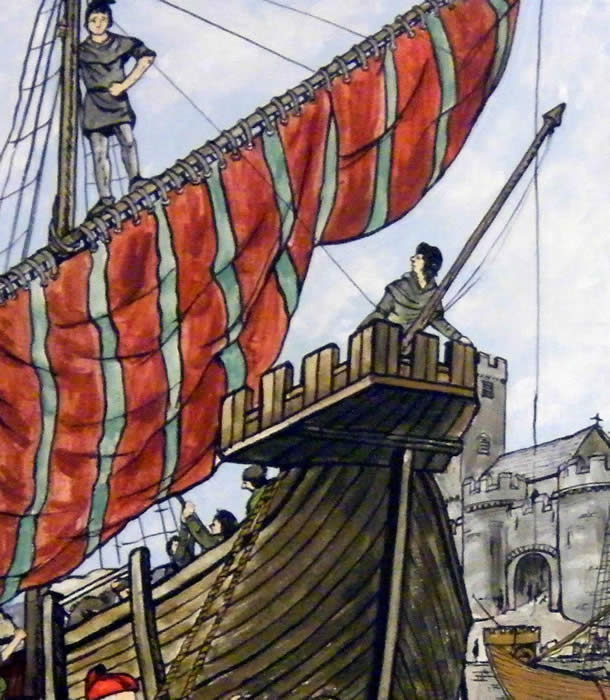 |
| Medieval Pembroke |
 |
| Wars of the Roses |
 |
| Tudor |
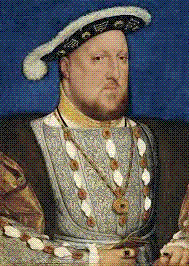 |
| Religious and political change |
 |
| Stuart & Civil War |
 |
| 18th Century |
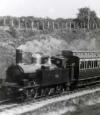 |
| 19th Century |
 |
| Modern Times |
